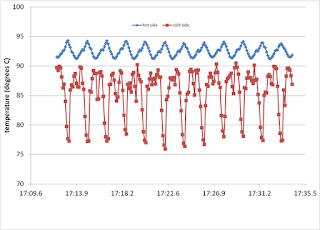As I indicated in my last post, one bedeviling factor in many renewable energy applications is the difficulty of making a cost-effective conversion device because it is so hard to make enough money to offset relatively high capital costs. Naturally, improvements in conversion efficiency can help on the money-making side. Another approach would be to try to pursue technologies where the capital cost (and typically, the efficiency) is low to begin with. If the primary energy source has a low enough cost (zero, for example) the low efficiency is not as big a concern. Note, however, that even with free energy and low capital equipment costs, there still remain many other costs such as land, maintenance, transport, etc. Nevertheless, technologies with low costs for capital equipment are worth exploring [1,2] and may be viable for some niche applications.
One such technology that may be promising is the liquid piston Stirling engine. These heat engines can be built very cheaply from a few pieces of pipe and tubing. While they tend to have very poor efficiency and power density, their very low capital cost could make them economical for some applications using free or low cost sources of heat.

Liquid piston Stirling engines use oscillating columns of liquid, typically but not necessarily, water, in place of the pistons of a traditional Stirling engine. This figure shows one common configuration (of many possible) with water held in a U-shaped tube and in a connecting “tuning” line. Oscillations of water in the U-tube shift the working fluid above the water (typically air) back and forth between the hot-side (heat input) and cold-side (heat rejection) of the engine. Oscillations of the water in the tuning column alternately compress and expand the working fluid. If the phasing is correct, the expansion occurs when the bulk of the working fluid is on the hot side, and the compression occurs when the bulk of the working fluid is cold, and the cycle produces net work. The work can be extracted from the oscillations of the liquid in either column, from the pressure fluctuations of the working fluid, or in other ways. In a properly designed system, the oscillations in both the U-tube and tuning column start moving spontaneously and with the proper phasing when heat input and extraction starts with the working fluid. An animation at the end of the post illustrates the fluid motions.
Liquid piston Stirling engines have had limited commercial success to power water pumps and have been proposed for electricity generation in a number of configurations. West provides a comprehensive overview of the theory and operation of these devices [3,4]. Active research continues on a variety of aspects and applications e.g. [5-7]. Because they have relatively poor power density and efficiency, they would tend to function best for small-scale applications using free or low-cost heat sources such as commercial waste heat or concentrated solar energy. Since the power output is proportional to the mean pressure of the working fluid as well as the working fluid volume and temperature difference, atmospheric engines using water for pistons have severe limitations on improvements of the power density. Other configurations are, of course, possible.
On the positive side, liquid piston Stirling engines can be constructed with very low capital cost as indicated previously. In addition, they are quite robust thermally and mechanically. They are self-starting with the input of heat, and function well within very loose design and construction tolerances.
References
[1] J.W. Mason and J.W. Stevens, 2011, “Design and Construction of a Solar-powered Fluidyne Test Bed” Proceedings of the ASME 2011 Mechanical Engineering Conference and Exposition IMECE2011, paper IMECE2011-62194.
[2] J.W. Stevens, 2010, “Low Capital Cost Renewable Energy Conversion With Liquid Piston Stirling Engines,” Proceedings of ASME 2010 4th International Conference on Energy Sustainability ES2010, paper ES2010-90129.
[3] West, C.D., 1983, Liquid Piston Stirling Engines, Van Nostrand Reinhold, N.Y.
[4] West, C.D., 1987, Stirling Engines and Irrigation Pumping, Oak Ridge National Laboratory Technical Report ORNL/TM-10475.
[5] Orda E. and Mahkamov, K., 2004, “Development of ‘Low-tech’ Solar Thermal Water Pumps for Use in Developing Countries,” J. Sol. Energy Eng. Vol. 126, pp. 768-774.
[6] Slavin, V.S., Bakos, G.C., Finnikov, K.A., 2009, “Conversion of thermal energy into electricity via a water pump operating in Stirling engine cycle”, Applied Energy, Vol. 86, pp. 1162-1169.
[7] Van de Ven, J.D., 2009, “Mobile hydraulic power supply: Liquid piston Stirling engine pump”, Renewable Energy, Vol. 34, pp. 2317-2322.






